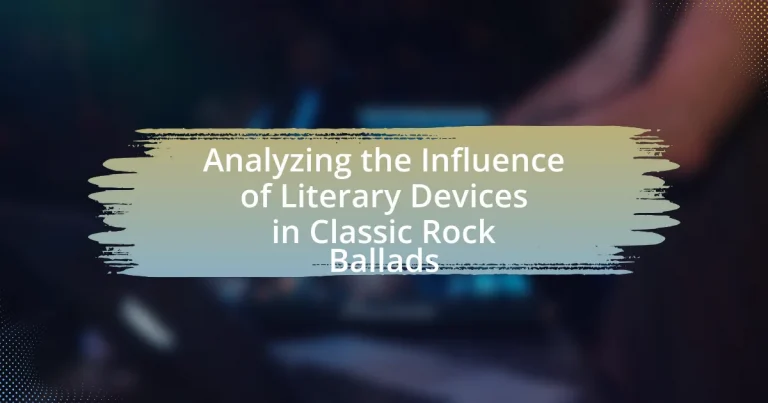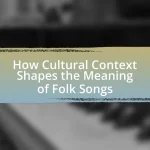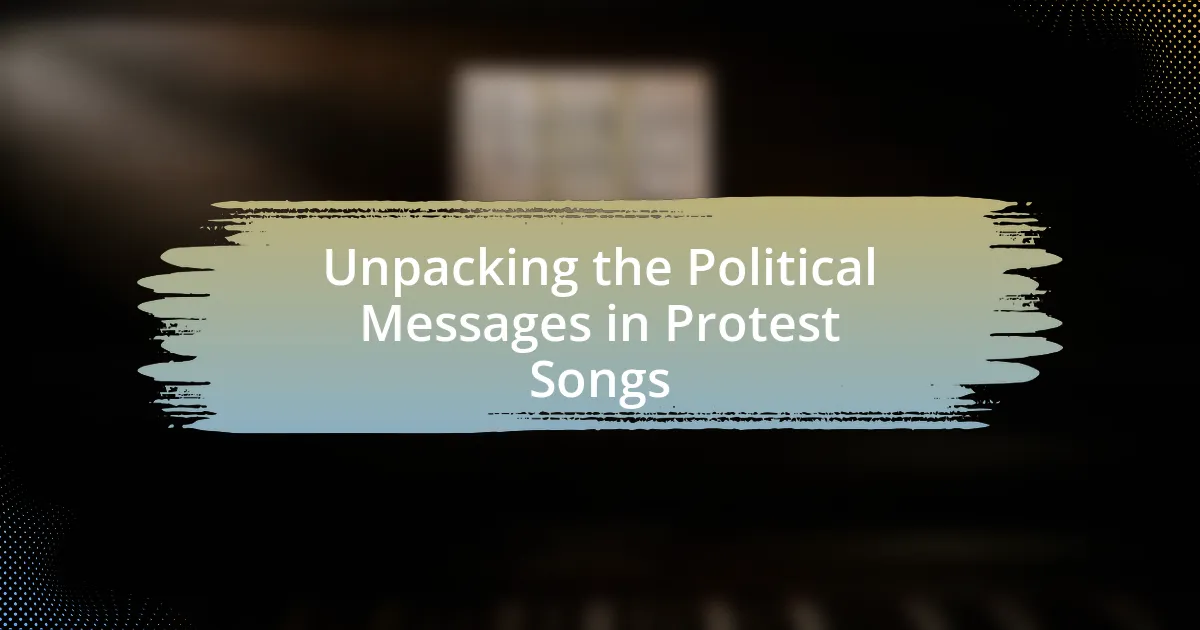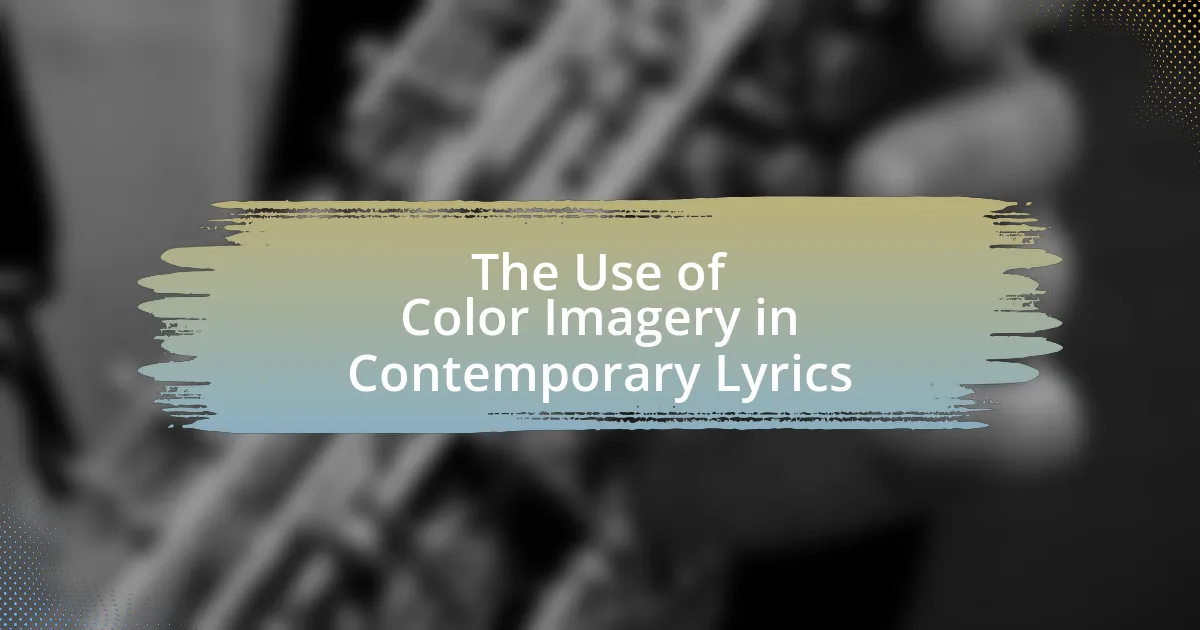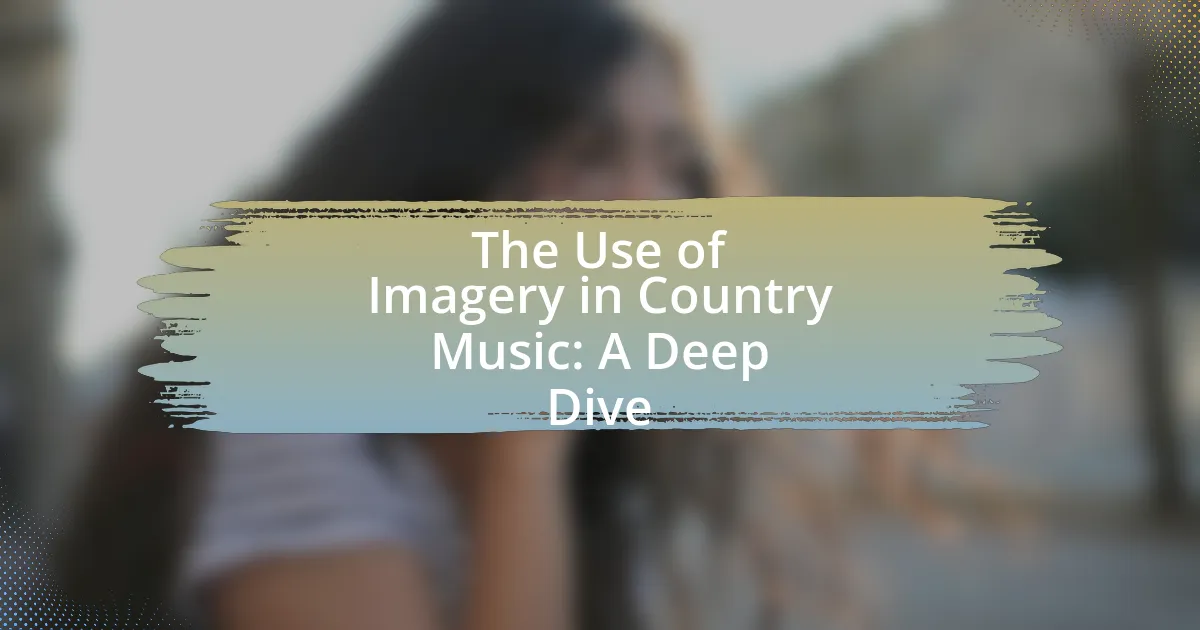The article focuses on the influence of literary devices in classic rock ballads, highlighting their role in enhancing storytelling and emotional depth. It examines various techniques such as imagery, metaphor, and repetition, illustrating how these devices contribute to the thematic complexity of songs. Key examples from iconic tracks like “Stairway to Heaven” and “Hotel California” demonstrate the effectiveness of these literary elements in evoking emotions and connecting with listeners across generations. The article also discusses methods for analyzing these devices, emphasizing the importance of context in interpreting the lyrics and their meanings.
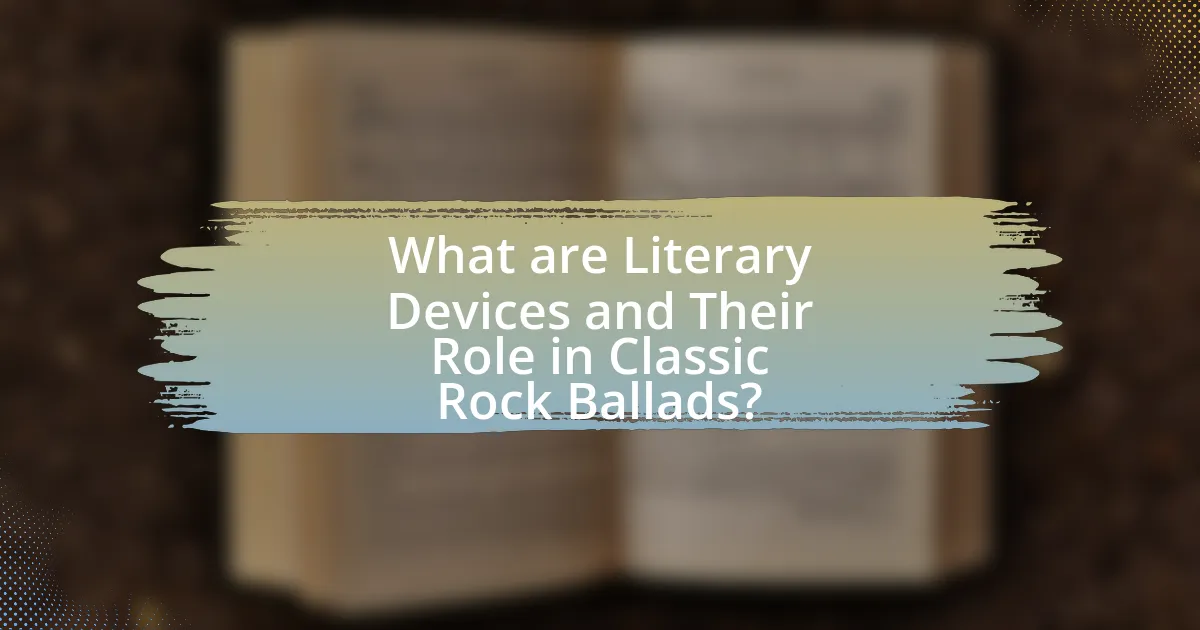
What are Literary Devices and Their Role in Classic Rock Ballads?
Literary devices are techniques used by writers to convey meaning, evoke emotions, and enhance the overall impact of their work. In classic rock ballads, these devices play a crucial role in storytelling, allowing artists to express complex themes such as love, loss, and rebellion. For instance, metaphors and similes create vivid imagery, while alliteration and rhyme contribute to the musicality of the lyrics. The use of narrative structure in songs like “Stairway to Heaven” by Led Zeppelin illustrates how storytelling can engage listeners on a deeper emotional level. Additionally, repetition emphasizes key messages, making them more memorable. Overall, literary devices enrich classic rock ballads, making them resonate with audiences and elevating the genre’s artistic expression.
How do literary devices enhance the storytelling in classic rock ballads?
Literary devices enhance storytelling in classic rock ballads by creating emotional depth and vivid imagery. These devices, such as metaphor, simile, and personification, allow songwriters to convey complex feelings and narratives in a relatable manner. For instance, the use of metaphor can transform personal experiences into universal themes, as seen in songs like “Stairway to Heaven” by Led Zeppelin, where the metaphor of a journey symbolizes life choices. Additionally, vivid imagery engages listeners’ senses, making the story more immersive; in “Hotel California” by the Eagles, descriptive language paints a haunting picture of entrapment. Overall, these literary techniques not only enrich the narrative but also resonate with audiences, making the songs memorable and impactful.
What specific literary devices are commonly used in classic rock ballads?
Classic rock ballads commonly utilize literary devices such as imagery, metaphor, and repetition. Imagery creates vivid mental pictures that evoke emotions, as seen in songs like “Stairway to Heaven” by Led Zeppelin, where descriptive language enhances the narrative. Metaphor allows for deeper meanings and connections, exemplified in “Fire and Rain” by James Taylor, where personal struggles are compared to natural elements. Repetition reinforces key themes and emotions, evident in “I Don’t Want to Miss a Thing” by Aerosmith, where repeated phrases emphasize longing and devotion. These devices contribute to the emotional depth and storytelling quality that characterize classic rock ballads.
How do these devices contribute to the emotional impact of the lyrics?
Literary devices such as imagery, metaphor, and repetition significantly enhance the emotional impact of lyrics in classic rock ballads. Imagery evokes vivid sensory experiences, allowing listeners to connect emotionally with the themes presented. For instance, the use of descriptive language can paint a picture of longing or heartbreak, making the listener feel the emotions more deeply. Metaphors create connections between abstract feelings and tangible experiences, facilitating a deeper understanding of complex emotions. Repetition reinforces key themes and emotions, making them more memorable and impactful. These devices work together to create a rich emotional landscape, drawing listeners into the narrative and enhancing their overall experience of the song.
Why are classic rock ballads significant in the music genre?
Classic rock ballads are significant in the music genre because they encapsulate emotional depth and storytelling, often resonating with listeners on a personal level. These ballads frequently utilize literary devices such as metaphor, imagery, and narrative structure, which enhance their lyrical content and emotional impact. For instance, songs like “Stairway to Heaven” by Led Zeppelin and “Hotel California” by the Eagles showcase intricate storytelling and vivid imagery, contributing to their lasting popularity and cultural significance. The ability of classic rock ballads to evoke strong emotions and connect with audiences has solidified their place in music history, influencing countless artists and genres that followed.
What themes are prevalent in classic rock ballads?
Classic rock ballads frequently explore themes of love, loss, and nostalgia. These themes resonate deeply with listeners, often reflecting personal experiences and emotional struggles. For instance, songs like “Stairway to Heaven” by Led Zeppelin and “Free Bird” by Lynyrd Skynyrd encapsulate the longing for connection and the pain of separation, illustrating how these emotional narratives are woven into the fabric of classic rock. The prevalence of these themes is supported by the genre’s focus on storytelling, where artists use vivid imagery and relatable situations to engage their audience, making the emotional impact of the music enduring and significant.
How do these themes resonate with listeners across generations?
Themes in classic rock ballads resonate with listeners across generations by addressing universal human experiences such as love, loss, and rebellion. These themes evoke strong emotional responses, making them relatable regardless of the listener’s age. For instance, songs like “Stairway to Heaven” by Led Zeppelin and “Bohemian Rhapsody” by Queen explore complex emotions and narratives that transcend time, allowing listeners from different eras to connect with the music on a personal level. Studies show that music with relatable themes can enhance emotional well-being, further solidifying the enduring appeal of these classic rock ballads across diverse age groups.

How do Different Literary Devices Influence the Meaning of Classic Rock Ballads?
Different literary devices significantly influence the meaning of classic rock ballads by enhancing emotional depth and thematic complexity. For instance, metaphors often convey profound feelings and experiences, as seen in “Stairway to Heaven” by Led Zeppelin, where the metaphor of a stairway symbolizes a journey toward enlightenment or materialism. Additionally, imagery creates vivid mental pictures that evoke specific emotions; in “Hotel California” by the Eagles, the imagery of a luxurious yet entrapping hotel reflects themes of excess and entrapment in the music industry. Furthermore, narrative structure allows for storytelling that engages listeners, as demonstrated in “The River” by Bruce Springsteen, where the personal narrative explores themes of loss and nostalgia. These devices collectively enrich the lyrics, allowing listeners to connect on multiple levels, thus deepening the overall impact of the ballads.
What is the impact of metaphor in classic rock ballads?
Metaphor significantly enhances the emotional depth and thematic complexity of classic rock ballads. By employing metaphor, songwriters create vivid imagery that resonates with listeners, allowing them to connect on a personal level with the lyrics. For example, in “Stairway to Heaven” by Led Zeppelin, the metaphor of a stairway symbolizes the journey of life and the pursuit of spiritual fulfillment, which has led to widespread interpretation and discussion among fans and critics alike. This use of metaphor not only enriches the narrative but also invites multiple interpretations, making the songs more relatable and impactful over time.
How do metaphors shape the listener’s interpretation of the song?
Metaphors significantly shape the listener’s interpretation of a song by creating vivid imagery and emotional resonance. They allow listeners to connect abstract concepts to tangible experiences, enhancing understanding and engagement with the song’s themes. For instance, in classic rock ballads, metaphors often convey complex emotions such as love, loss, or rebellion, making the lyrics more relatable and impactful. Research indicates that metaphorical language activates specific neural pathways associated with emotional processing, thus deepening the listener’s connection to the music. This cognitive engagement is crucial in classic rock, where storytelling and emotional depth are central to the genre’s appeal.
Can you provide examples of effective metaphors in classic rock ballads?
Effective metaphors in classic rock ballads include “the wind of change” in Scorpions’ “Wind of Change,” symbolizing hope and transformation after the Cold War. Another example is “a heart of glass” in Blondie’s “Heart of Glass,” representing vulnerability and fragility in love. Additionally, “the stairway to heaven” in Led Zeppelin’s “Stairway to Heaven” serves as a metaphor for the pursuit of spiritual enlightenment and the complexities of life choices. These metaphors enhance emotional depth and resonate with listeners, illustrating the power of literary devices in music.
How does imagery play a role in the emotional depth of classic rock ballads?
Imagery significantly enhances the emotional depth of classic rock ballads by creating vivid mental pictures that resonate with listeners. This literary device allows songwriters to evoke strong feelings and connect personal experiences to universal themes, such as love, loss, and longing. For instance, in “Stairway to Heaven” by Led Zeppelin, the imagery of a “stairway” symbolizes a journey toward enlightenment, which deepens the emotional impact of the song. Similarly, in “Hotel California” by the Eagles, the imagery of a luxurious yet entrapping hotel reflects themes of excess and entrapment, intensifying the listener’s emotional response. Such concrete visual elements not only enhance the storytelling aspect of the lyrics but also facilitate a deeper emotional engagement, making the songs memorable and relatable.
What types of imagery are most commonly found in these songs?
Classic rock ballads commonly feature vivid imagery that evokes strong emotions and paints detailed scenes. This includes natural imagery, such as landscapes and weather, which often symbolize the characters’ feelings or situations, as seen in songs like “Dust in the Wind” by Kansas. Additionally, emotional imagery is prevalent, capturing feelings of love, loss, and nostalgia, exemplified in “Tears in Heaven” by Eric Clapton. These types of imagery enhance the storytelling aspect of the songs, allowing listeners to connect deeply with the themes presented.
How does imagery enhance the listener’s experience?
Imagery enhances the listener’s experience by creating vivid mental pictures that evoke emotions and deepen engagement with the music. When classic rock ballads utilize descriptive language, they allow listeners to visualize scenes and feel the emotions conveyed, making the narrative more relatable and impactful. For example, in “Hotel California” by the Eagles, the imagery of a haunting hotel creates a sense of intrigue and foreboding, drawing listeners into the story. This connection between imagery and emotional response is supported by research from the Journal of Music and Emotion, which indicates that vivid imagery in lyrics can significantly enhance emotional engagement and memory retention in listeners.

What are the Common Techniques Used in Analyzing Literary Devices in Classic Rock Ballads?
Common techniques used in analyzing literary devices in classic rock ballads include thematic analysis, lyrical dissection, and contextual interpretation. Thematic analysis identifies recurring motifs and messages within the lyrics, revealing the emotional and narrative depth of the songs. Lyrical dissection involves examining specific word choices, metaphors, and similes to understand how they contribute to the overall meaning and impact of the ballad. Contextual interpretation considers the historical and cultural background of the song, providing insight into the artist’s intentions and the societal influences at the time of its creation. These techniques collectively enhance the understanding of how literary devices shape the storytelling and emotional resonance in classic rock ballads.
How can one effectively analyze the use of literary devices in a classic rock ballad?
To effectively analyze the use of literary devices in a classic rock ballad, one should identify and examine specific devices such as imagery, metaphor, and symbolism within the lyrics. Analyzing imagery involves looking at descriptive language that evokes sensory experiences, while metaphor analysis focuses on comparisons that convey deeper meanings. Additionally, exploring symbolism reveals how certain objects or phrases represent broader themes, such as love or loss. For instance, in “Stairway to Heaven” by Led Zeppelin, the metaphor of a stairway symbolizes the journey of life and the pursuit of spiritual fulfillment. This approach allows for a comprehensive understanding of how these devices contribute to the emotional impact and thematic depth of the ballad.
What steps should be taken to dissect the lyrics for literary elements?
To dissect the lyrics for literary elements, one should follow a systematic approach that includes identifying key literary devices, analyzing their effects, and interpreting the overall meaning. First, identify literary devices such as metaphors, similes, imagery, and symbolism within the lyrics. Next, analyze how these devices contribute to the emotional tone and themes of the song. For instance, metaphors can create vivid imagery that enhances the listener’s emotional experience. Finally, interpret the lyrics in the context of the song’s narrative and the broader cultural or historical background, which can provide deeper insights into the artist’s intent and the song’s impact. This methodical approach ensures a comprehensive understanding of the literary elements at play in classic rock ballads.
What tools or resources can assist in this analysis?
Text analysis software such as Voyant Tools and AntConc can assist in analyzing the influence of literary devices in classic rock ballads. These tools enable users to perform quantitative analysis of lyrics, identifying patterns in word usage, frequency, and thematic elements. For instance, Voyant Tools provides visualizations that help in understanding the prominence of specific literary devices, while AntConc allows for concordance searches to examine context and usage of particular phrases or terms. Additionally, academic resources like JSTOR and Google Scholar offer access to research papers that discuss literary analysis techniques and their application to music, providing theoretical frameworks and case studies relevant to classic rock ballads.
What are some best practices for appreciating literary devices in classic rock ballads?
To appreciate literary devices in classic rock ballads, listeners should actively analyze the lyrics for metaphors, similes, and imagery that convey deeper meanings. Engaging with the text allows for a richer understanding of the emotional and thematic elements present in the music. For instance, songs like “Stairway to Heaven” by Led Zeppelin utilize metaphorical language to explore themes of life and spirituality, enhancing the listener’s experience. Additionally, examining the song structure, such as the use of repetition and rhyme schemes, can reveal how these devices contribute to the overall impact of the ballad. This approach not only deepens appreciation but also fosters a connection to the cultural and historical context of the genre.
How can listeners deepen their understanding of the lyrics?
Listeners can deepen their understanding of the lyrics by analyzing the literary devices used within the songs. Engaging with elements such as metaphor, imagery, and symbolism allows listeners to uncover deeper meanings and emotional nuances embedded in the lyrics. For instance, classic rock ballads often utilize metaphors to convey complex feelings, which can be explored through close reading and interpretation. Research indicates that understanding these devices enhances comprehension and appreciation of the music, as highlighted in studies on lyrical analysis in music psychology.
What role does context play in interpreting literary devices in these songs?
Context plays a crucial role in interpreting literary devices in classic rock ballads by providing the background necessary to understand the themes, emotions, and messages conveyed in the lyrics. For instance, the historical and cultural context of the 1960s and 1970s, marked by social upheaval and personal struggles, influences how metaphors and imagery are perceived, allowing listeners to connect deeply with the artists’ intentions. Songs like “The Sound of Silence” by Simon & Garfunkel utilize imagery that reflects societal alienation, which resonates more profoundly when one considers the era’s political and social climate. This contextual understanding enhances the interpretation of literary devices, making them more meaningful and relevant to the listener’s experience.
